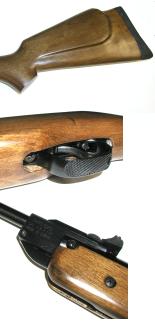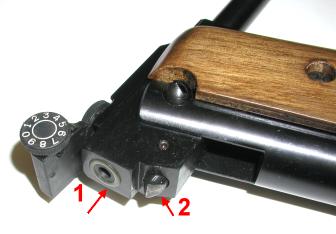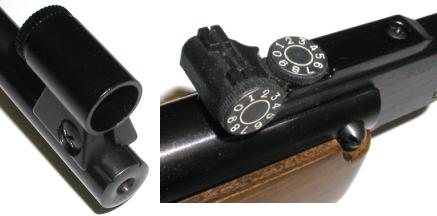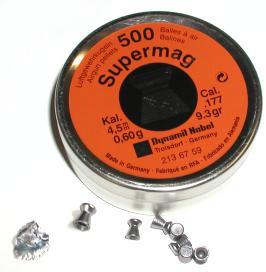High powered rifles are very loud. Consequently, shooting them requires lots of space, and rifle ranges aren’t typically constructed next to the local in-town dry cleaners, or neighborhood McDonalds….although events within some urban centers may suggest otherwise. A trip to our closest high power rifle range, Chabot Gun Club represents a round trip travel time of two hours, so I find myself waiting until I have several projects worth of shooting before going on this excursion. I’ve had a number of people suggest an air rifle would present local shooting opportunities, but recollections of deteriorating spring power, friction burn inducing downward trajectory, and Daisy Red Rider comic book sourced lever action BB guns, caused me to not move in this direction. More recently, however, driven by a chronograph related project that required constant test firing, I decided to investigate air rifle potential.

Next up are the mostly pellet shooting, sometimes BB shooting, mostly rifled bore guns, where air pressure is generated by manual pumping a lever, or forearm in the case of the .177 caliber Crosman2100B, and stored until the trigger is pulled. A nozzle positioned behind the projectile propels it to a range of 700~800 fps, but this level of performance takes a lot of effort. One pump will get you 300~400 fps, up to 10 pumps for real power. Not the situation you’d want to be in for a quick second shot on a brown bear hunt, but for $60, not bad performance.

Comparable in power to the pump guns, are the lazy boy versions where pressure is provided by one or more CO2 cylinders. Often repeaters of 5~8 shots, pellets are driven at approximately 600~650 fps. These are pricey, with guns such as the Walther U-4600000 coming in above $250, others hundreds of dollars higher. They are fun to shoot, they pack a pretty good punch and are convenient as long as you don’t mind feeding them CO2 Powerlets at 70 cents each to get 60 full power shots. These typically have a rifled bore and are quite accurate
Gamo is a very popular brand of air rifle. Billing its Hunter 1250 as the most powerful air rifle in the world, they offer a broad range of guns fitting most every application. Gamo uses spring – piston technology for propulsion; a piston capped coil spring is compressed when the gun is single stroked cocked then, at the pull of the trigger, the piston drives forward, pressurizing an air chamber behind the pellet and propelling the pellet forward with considerable force. The all rifled barrel line up yields .250″~.300″ 30 yard accuracy, which is very good for field use. The low end Gamo Delta, 525 fps runs about $90, the Hunter 1250, approximately $400. In reality, there are more powerful guns.

So you say you want to quite your job as a tree surgeon / satellite dish installer and become an Olympic pellet gun champ? You’ll probably need a Beeman FWB P70 and pre-charged pneumatic power plant. With 570 fps of muzzle velocity, the ability to shoot 10 meter .04″ groups (yes, the decimal position is correct), and an aluminum and laminated stock, you’ve got a $2,000 wonder gun. Oh, you’ll also need a scuba tank with about 3,000 P.S.I. of compressed air, because that’s how the gun’s pneumatic cartridges are loaded. Beeman does make guns for us bottom feeders, like the spring – piston RI sporting rifle for only $500.

RWS, Dynamit Nobel, markets a lot of air guns, produced in a variety of places. The Model 54 Magnum, left, is a spring – piston gun that produces 1,100 fps velocity with .177 caliber pellets. This model runs about $500 and is made by Diana Manufacturing of Germany. A Model 34, same origin, offering 1,000 fps performance runs about half the price of the Model 54, and there is a new Chinese manufactured spring – piston model I will cover later in detail, that sells for about $100.
 RWS also offers the biggest damn bore air rifle I’ve ever seen, the Ultra 9MM Repeater. The Ultra (right) throws a 60 grain .357″ pellet at over 940 fps. Made by Shinsung Industries Manufacturing in South Korea, the gun holds 18 rounds and is charged with a scuba tank, or a manual pump, however, initial filling could take several hundred pump strokes to fill, then approximately one pump for every two shot fired afterward. Pellets for this gem sell for $7/60 and a RWS Compressed Air Hand Pump will set you back $200 if your SCUBA gear is tied up in the shop.
RWS also offers the biggest damn bore air rifle I’ve ever seen, the Ultra 9MM Repeater. The Ultra (right) throws a 60 grain .357″ pellet at over 940 fps. Made by Shinsung Industries Manufacturing in South Korea, the gun holds 18 rounds and is charged with a scuba tank, or a manual pump, however, initial filling could take several hundred pump strokes to fill, then approximately one pump for every two shot fired afterward. Pellets for this gem sell for $7/60 and a RWS Compressed Air Hand Pump will set you back $200 if your SCUBA gear is tied up in the shop.While there are many brand names affixed to guns, business consolidation over the years means only a handful of companies actually provide the bulk of what the market has to offer. As an example, the Daisy site covers: Avanti, Colt, Daisy, Powerline, and Winchester; BB guns, air rifles and pistols. At the Crosman site you’ll find Benjamin-Sheridan, Crosman, Smith & Wesson and Walther brands. Stand alone brands are Beeman, Gamo and RWS. Better yet, if you hit a site like Cabela’s they have virtually all guns in inventory and, even if you don’t want to purchase from them, you can get a realistic representation of discount retailer pricing.
If I get one, what the heck can I do with it?
The short answer is, about anything that is suitable for the .22 rim fire, with the proper selection of power range and pellet size. Bore sizes are generally: .177, .20, .22, and .25 calibers, with .177 the overwhelming popularity champ. Beeman, suggests their .25 caliber high velocity guns are suitable for hunting animals such as woodchuck, opossum and even raccoon. Best deal yet, since most are very accurate, even the inexpensive models can be used for meaningful, target practice almost anywhere.
Spring – piston guns do make a little bit of noise, about like a modest hand clap. Scuba tank pressure loaded guns are a bit louder, caused by the high velocity air flow leaving the barrel. All types, except spring – piston can be dry fired; without the resistance of a seated pellet to dampen its travel, the piston will be damaged when it slams into the face of the air compression chamber. Guns with springs should not be left cocked as the spring will deteriorate rather quickly. Properly used, these guns have a good deal of longevity with 10,000 rounds about the norm. Seals and replacement springs are offered by virtually all product suppliers.
The proper air rifle could make for a great youth training rifle, especially those that have real firearms looks and weight, are single shot and have traditional firearm safety operation. The only caution is that their use requires as much supervision and security as a smokeless powder firearm, and anything less would only serve to establish less than safe habits for new shooters.
My cost effective (aka cheap) purchase decision

I decided on a recently released model, the RWS 320, for a number of reasons; it was advertised as having 1,000+ fps performance, it is of spring-piston type design, a decent Asian walnut stock and all steel barrel provide traditional rifle heft and feel and, most of all, it was the lowest priced gun of this type. I bought mine fromCabela’s for $109.00 and received it in California in 3 days via UPS. Oddly enough, CA, the big girl gun control capitol of the world, does not have special restrictions on air rifles and pistols, however, MI, NY, NJ & IL apparently have discovered single shot air rifles are the weapon of choice for street gangs, bank robbers and other assorted and sundry felon types.

The Model 320, which looks amazingly similar to models sold by China Shanghai as their B60, is large. At 6.75 lbs the weight isn’t a problem, but the flat forearm is 2″ x 3″ and the pull in 14.25″, about 3/4″ longer than a big Weatherby. The geometry must work, however, as the gun is quite comfortable to shoot and easy to hold on target. The cheek piece at first seems out of place, but works well to align the eye with the high mounted metallic sights. The 2 stage trigger pull, as received, was approximately 4.5 lbs. but it is fully adjustable though a hole cut through the bottom of the trigger guard and I had no problem shaving a full pound off the original setting. The trigger guard’s appearance is a little curious, the bottom surface is cleanly checkered, but the guard is sunk up into the walnut wood stock about half an inch.
The slab sided hinged breech resides at the very end of the forearm, and is marked RWS 320 Cal. 4.6 / .177 Made in China. Many air rifles of this type, regardless manufacturer, are of the same design, with the same physical attributes; clones of the Beeman R9. There is a large groove cut into the under side of the stock to make room for the cocking mechanism, and some pivot screws stuck Frankenstein style through the stock. The wood is smooth, the bluing is okay, the metal work is a little rough, but competently done, and certainly better than the toy like appearance of the lowest end BB and pellet guns. The recoil pad is a gem, better than the little neoprene pad on my Winchester.
 The gun is loaded by pulling back on the barrel to engage the internal safety system, then rotating it down to cock the spring and expose the chamber. The barrel takes a considerable tap to break open, and cocking effort is about 33 lbs.
The gun is loaded by pulling back on the barrel to engage the internal safety system, then rotating it down to cock the spring and expose the chamber. The barrel takes a considerable tap to break open, and cocking effort is about 33 lbs.The barrel is solid steel, not plastic wrapped around tubing. There is a large sealing ring (1) circling the chamber. (2) there is a beefy locking latch to hold it altogether when closed up. The rear sight is mounted on the same surface as the front sight for increased accuracy.
 The 320 has a pretty beefy sighting system. Micro adjustable windage and elevation, changeable front; clamped to front barrel grooves for easy R&R. Adjustment positions are secured with spring loaded ball detents. The rear blade has a .055″ notch, the front post is about the same. The rifle’s receiver is grooved for scope mounting. My eyesight is crap, but I had no problem shooting 25 feet at relatively small targets. The gun is very comfortable to shoot from the bench or off hand, now that I no longer smoke and can actually control my breathing to some degree…although I do miss that wheeze.
The 320 has a pretty beefy sighting system. Micro adjustable windage and elevation, changeable front; clamped to front barrel grooves for easy R&R. Adjustment positions are secured with spring loaded ball detents. The rear blade has a .055″ notch, the front post is about the same. The rifle’s receiver is grooved for scope mounting. My eyesight is crap, but I had no problem shooting 25 feet at relatively small targets. The gun is very comfortable to shoot from the bench or off hand, now that I no longer smoke and can actually control my breathing to some degree…although I do miss that wheeze. Air rifles are powerful enough to dispatch lots of little things, and there is a selection of ammo to fit each task. Field points are good for pest control. There are broad flat tipped target pellets, designed to leave cookie cutter holes in targets to facilitate easy scoring. There are hollow points for expansion, domed points for cross over – target and field and Super Mag tips for people like me who think the Mag nomenclature means something. The .177″ calibers run between 8~10 grains, the .22 caliber, 13~15 grains, $6/500 and $9/500 respectively. Pressed felt cleaning pellets run approximately $6/100; a
Air rifles are powerful enough to dispatch lots of little things, and there is a selection of ammo to fit each task. Field points are good for pest control. There are broad flat tipped target pellets, designed to leave cookie cutter holes in targets to facilitate easy scoring. There are hollow points for expansion, domed points for cross over – target and field and Super Mag tips for people like me who think the Mag nomenclature means something. The .177″ calibers run between 8~10 grains, the .22 caliber, 13~15 grains, $6/500 and $9/500 respectively. Pressed felt cleaning pellets run approximately $6/100; a So how did it go?
 I initially had a difficult time getting the gun to break to load. I thought for a moment, there might have been a hidden camera capturing me alligator wrestle this thing to the ground until the barrel finally gave up and tipped open. It’s like breaking open a tight fitting T/C Contender, you just need to develop that knack. After a few rounds of cycling, the process was easy. The little ball point pen bullseye to the right caught the first 5 shots, off hand, at 25 feet. The group is under half an inch, and was easy to shoot, even though the single shot required opening the gun after each round.
I initially had a difficult time getting the gun to break to load. I thought for a moment, there might have been a hidden camera capturing me alligator wrestle this thing to the ground until the barrel finally gave up and tipped open. It’s like breaking open a tight fitting T/C Contender, you just need to develop that knack. After a few rounds of cycling, the process was easy. The little ball point pen bullseye to the right caught the first 5 shots, off hand, at 25 feet. The group is under half an inch, and was easy to shoot, even though the single shot required opening the gun after each round.Most pellet traps aren’t designed for this level of power, there is like a 650~700 fps cut off, and I have a hole in some baseboard molding that stands in silent testimony of the power of the pellet. I creatively stuffed a heavy corrugated 12″x12″ box full of the weekend newspaper, each section (except the NY Giant TV schedule) crunched up and packed in until the box was tightly filled. Worked like a champ, including shooting over the chronograph to verify velocity between 950 and 975 fps. And so began our intra office lunch time matches, and leaving lunch crumbs around while waiting for a marauding rodent…..
Thanks
Joe

Email Notification